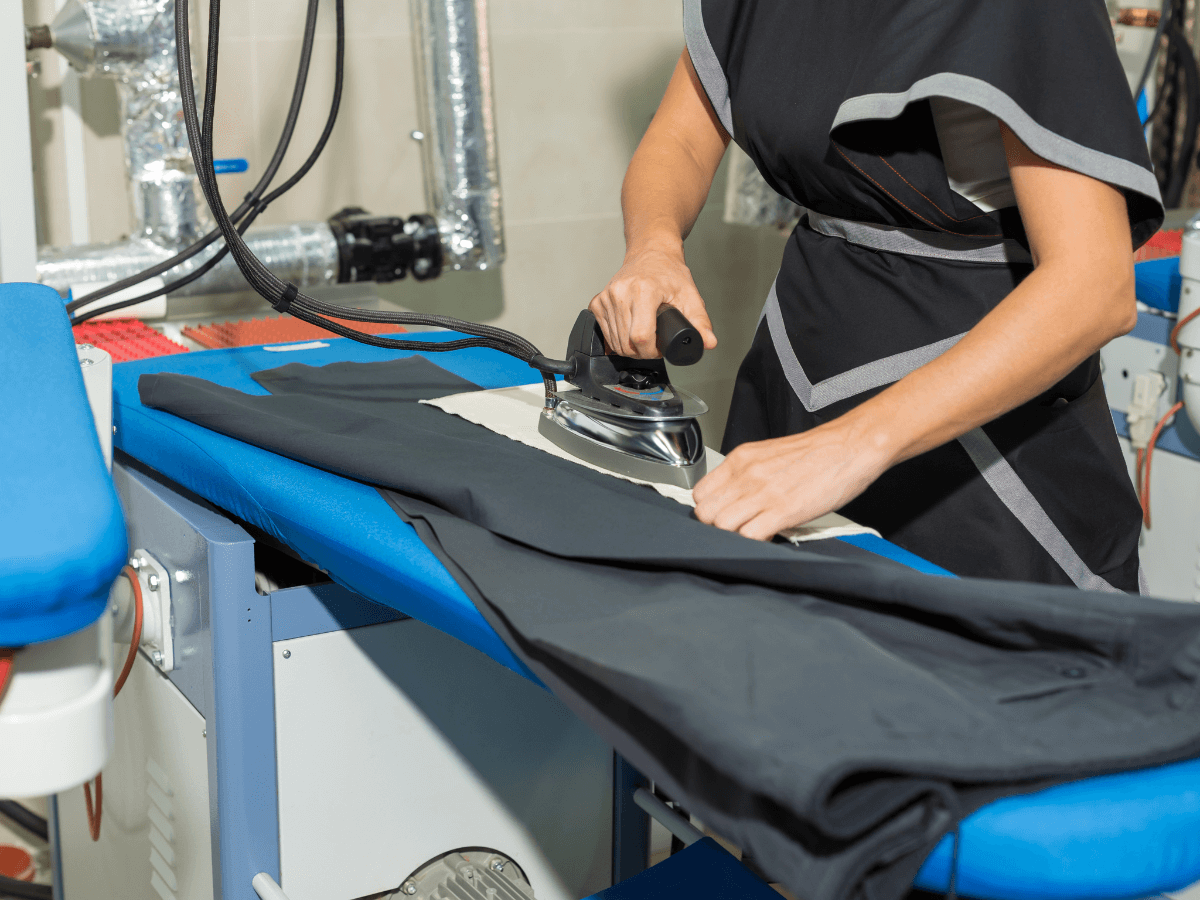Dry cleaning is a unique process that involves cleaning clothes and fabrics without the use of water. Instead, this technique employs various solvents to remove stains and dirt, thereby maintaining the quality and appearance of your cherished garments. Understanding the dry cleaning procedure and the type of equipment used can help you appreciate this highly specialized method and its importance in preserving your delicate fabrics.
The technicality carried out during dry cleaning is fascinating and a mixture of science and art. Various solvents are used to penetrate fabrics and break down different types of stains without damaging the garment. This involves utilizing specialized dry cleaning machinery that treats, dries, and refines your cloth pieces, ensuring they are not only clean but also crisp and fresh as new.
The choice of fabrics and garments that go for dry cleaning is equally critical. Certain materials cannot withstand the harshness of regular washing and need special care. Therefore, dry cleaning becomes essential for such garments.
Moreover, mastering the art of spot treatment or stain removal is quite crucial in the dry cleaning process. Different solutions are used to dissolve specific stains without discoloring or damaging the fabric, offering a deep clean that regular washing cannot achieve.
Lastly, we will also provide insight into the possibility of dry cleaning at home. Despite the complexities involved, with the right advice and approach, home dry cleaning may become a viable option for some of your clothing items.
Get ready to dive into a world of solvents, machines, fabrics, stains, and everything dry cleaning!
Dry Cleaning Process 101

Dry cleaning is an essential cleaning process extensively used in modern times to clean materials that may degrade or lose their physical properties with exposure to water or heat. This process involves immersing clothes in a solvent, tetrachloroethylene, more commonly known as “perc”, that effectively removes dirt and stains without shrinking or damaging the fabric.
The practice of dry cleaning originated in ancient Rome, where clothes were cleaned using ammonia derived from urine. The technology evolved, and in the 19th century, a person named Jean-Baptiste Jolly, from France, stumbled upon modern dry cleaning when he noticed how kerosene cleaned a tablecloth’s stains. Today, dry cleaning has revolutionized laundry work, providing a handy solution for maintaining delicate garments and suits.
There are several advantages of dry cleaning. Firstly, it facilitates the removal of tough stains and grease, which water and ordinary detergent may struggle with. Secondly, it ensures that colorfastness and material integrity are maintained, extending the lifespan of garments. Finally, it offers professional pressing, which leaves the fabric with a crisp and smooth finish.
However, dry cleaning also comes with some drawbacks. The chemicals used in dry cleaning, specifically tetrachloroethylene, can raise environmental and health concerns. Extended exposure to these chemicals can lead to health problems such as skin irritation, dizziness, and vision problems. Additionally, regular dry cleaning could potentially become costly over time, especially for larger families.
Despite the disadvantages, dry cleaning remains a vital service within the textile and clothing industry.
Dry Cleaning Solvents 101

Dry Cleaning Solvents 101 is a subject encompassing the variety of cleaning liquids used in the dry cleaning process, effectively eliminating dirt and stains without the use of water. The most common and traditionally used solvent in the dry cleaning industry is Perchloroethylene, commonly referred to as PERC. This chlorinated solvent is highly effective in stain removal but its usage has been criticized due to environmental and health concerns.
Due to such concerns, alternative solvents such as Hydrocarbon solvents have been introduced. Hydrocarbon solvents are petroleum-based and represent a more environmentally friendly choice than PERC, though they are not quite as effective in stain removal. Recently, green solvents have gained popularity, becoming a staple for eco-friendly dry cleaners. They are made from naturally occurring substances like fermented corn sugars and have the least environmental impact. These solvents are safe for most fabrics and efficient in treating stains.
However, they may cost more than traditional dry-cleaning solvents. By understanding the basics about dry cleaning solvents, one can make more informed decisions when choosing a dry cleaning service, giving consideration not only to effectiveness but also environmental and health impacts. Dry Cleaning Solvents 101 thus provides essential knowledge on the different cleaning liquids you might encounter in your quest for a clean wardrobe.
Dry Cleaning Equipment and Machinery 101

Dry Cleaning Equipment and Machinery 101 is an introductory crash course to the machinery and tools crucial to the operation of a dry cleaning business. The key element in carrying out the dry-cleaning process is, of course, a dry-cleaning machine. These impressive machines can hold up to 80 pounds of garments at a time and function by utilizing environmentally friendly cleaning solvents, rather than water.
Dry cleaning machines easily and effectively remove stains and odors from fabrics, the process also limits garment shrinkage and discoloration. Another integral part of the equipment line-up is the pressing machines. These come in to play post-dry-cleaning and ensure your clothes are not wrinkled. Pressing machines help to restore the garment to its original shape, whether it be blazers, trousers, or any other clothing item. They work quickly and efficiently to deliver a clean and crisp garment ready for collection.
Lastly, spotting machines are absolute game-changers in the dry cleaning industry. These specialized machines are designed to remove stubborn stains that the dry cleaning machines couldn’t tackle. They are equipped with steam jets and specific stain-removing chemicals to handle a variety of stubborn stains from garments.
In sum, these three pieces of machinery; the dry cleaning machines, pressing machines, and spotting machines, make up the core backbone of any modern and environmentally friendly dry cleaning service. Understanding Dry Cleaning Equipment and Machinery 101 is pivotal for anyone venturing into this industry.
Dry Cleaning Garments and Fabrics 101

Dry Cleaning Garments and Fabrics 101 is a comprehensive guide to understanding the art and science of maintaining the quality, color, and longevity of your garments. It is interesting to learn that not all clothes are suitable for dry cleaning and it is often reserved for certain types of garments.
Delicate items such as silk, wool, velvet, and items adorned with sequins, beads, or intricate lacework are prime candidates for this process. When handled correctly, dry cleaning can prevent these items from shrinking, bleeding colors, or losing their shape, ensuring they keep their brilliance for longer.
Delicate fabrics do require extra care and attention. Gentle handling, precise temperature control, and appropriate cleaning agents are crucial to avoid damaging these fine materials. That’s where professional dry cleaning services prove their worth, as they have specialized knowledge and equipment at their disposal.
For materials like leather and suede, special considerations are required. These fabrics can lose their texture, color, or shape if not handled correctly. Specialized cleaning techniques are used to protect and nourish these high-quality materials, allowing them to maintain their natural look and feel for many years. In conclusion,
Dry Cleaning Garments and Fabrics 101 underscores the value of dry cleaning in preserving and extending the life of our cherished clothing items.
Dry Cleaning Stain Removal 101

In the realm of stain removal, Dry Cleaning Stain Removal 101 provides the ultimate guide for managing common stains and utilizing effective techniques to eliminate them. The process of dry cleaning is unique, and not just any stain remover will work.
Common stains such as oil-based stains, tannin stains, protein stains, dye stains, and combination stains each require a specific treatment. These treatments can range from utilizing hydrocarbon solvents for oil-based stains to using protein-digesting enzymes for organic protein stains like blood, milk, or sweat.
Professional dry cleaners utilize various techniques to remove these stains, including the use of specialized stain removal agents, careful application techniques, and employing heat and steam to lift stains from the fabric. In addition, pre-treatment options play a vital role in effective stain removal.
This step involves identifying the type of stain and fabric, and applying an appropriate spotting agent before the actual cleaning takes place. These techniques not only ensure the stain disappears but also prevent possible damage to the clothing.
Understanding the science behind stain removal is key to ensuring the longevity and maintained quality of your garments. As part of Dry Cleaning Stain Removal 101, it’s important to keep in mind that each stain is unique and should be treated accordingly, requiring both expertise and precise techniques for effective removal.
Dry Cleaning at Home 101

Dry Cleaning at Home 101 is a set of guidelines developed to help individuals effortlessly manage the dry cleaning of their clothes at home, thus making their lives easier while saving some money in the long run. The primary tool for this process is a home dry cleaning kit, which is easily available on the market nowadays.
These kits typically include a stain remover, a dryer-activated cloth, and sometimes a reusable dryer bag. The instructions on these kits are usually straightforward, typically involving treating any spots with the provided stain remover, placing the garments with the dryer-activated cloth in the bag, and then running the bag in the dryer on medium heat for about 30 minutes.
However, there are some tips to make home dry cleaning even more effective. For instance, it’s crucial not to overload the bag because the clothes need room to tumble. Also, remember this method is best suited for refreshing garments, and removing odors, light stains, and wrinkles, it’s not intended to clean heavily soiled clothes. It’s essential to understand the limitations of home dry cleaning too.
Not all types of clothes can be safely cleaned at home with a kit. Some garments, especially those with delicate fabrics or heavy stains, should still be taken to a professional dry cleaner to avoid damaging them. Therefore, Dry Cleaning at Home 101 is all about using the right tools and techniques smartly and understanding when to rely on professionals.
FAQs
Q: What is the basic idea behind dry cleaning and how does a dry cleaner work?
A: Dry cleaning 101 teaches us that the method of cleaning in dry cleaning does not use water. Instead, a special solvent is used which does not penetrate the fibers in the same way as water. The solvent used, typically non-toxic petroleum-based, soaks the linen, dissolves stains, and is then extracted. This allows the dry cleaning to clean without damaging the fiber of the garment, providing the final product without any shrinkage or color distortion.
Q: What kind of chemicals are used in dry cleaning?
A: The primary solvent used in dry cleaning is a non-toxic petroleum-based product. However, in the past, more flammable or hazardous chemicals were used. Nowadays, many dry cleaners are shifting towards using closed-loop systems that purify and recycle solvents to reduce their carbon footprint.
Q: How does dry cleaning work on different types of fabrics?
A: Dry cleaning work differs depending on the type of fabric. Fabrics like polyester and rayon react well to dry cleaning as it does not shorten their lifespan like traditional washing can. Conversely, fabrics made of cotton can often be washed with water without any problem. Your local dry cleaner will be able to guide you on the best treatment for your garment’s fiber.
Q: Who invented dry cleaning and when?
Dry cleaning was invented in 1821 by Jean-Baptiste Jolly, a French dye-works owner. The invention was accidental; Jolly spilled lamp oil on a soiled tablecloth, which surprisingly came out cleaner. Jolly considered this solvent’s cleaning potential and started offering a new service popularly known as “nettoyage à sec”, which means dry cleaning.
Q: How often to dry clean one’s clothes?
A: The frequency of dry cleaning greatly depends on the garment and how often it’s worn. A good guide to dry cleaning is to follow the care label on the garment. However, a general rule of thumb is that formal and delicate item need to be dry-cleaned more often than casual and durable clothes.
Q: Is it possible to freshen up clothes without dry cleaning?
A: Yes, you can freshen up your clothes without dry cleaning. Brushing, airing, and spot cleaning can often remedy minor stains or odors. However, certain stains and fabrics will require the use of a dry cleaner to fully remove the stains.
Q: How to find a good dry cleaner locally?
A: Finding a good dry cleaner may require a bit of research. Look for dry cleaners that have on-site cleaning as this generally means they have a better handle on quality control. Good customer service, understanding of different fabrics, and process transparency can signify a good dry cleaner. Sometimes paying a few extra dollars can lead to significantly better dry cleaning work.
Q: What’s the difference between “dry cleaning” and “wet cleaning”?
A: The main difference between “dry cleaning” and “wet cleaning” is the use of water. While both methods use liquids to clean, “dry cleaning” refers to cleaning clothes without the use of water, using a special solvent instead. On the other hand, wet cleaning uses water and a gentle detergent in a computer-controlled process that regulates temperature and agitation.
Q: What happens if a spill occurs on a garment that is labeled only “dry clean”?
A: When a spill occurs on a garment labeled “dry clean only,” it is typically recommended to get it to a dry cleaner as soon as possible. However, you can also blot (not rub) the spill with a dry cloth to prevent the spill from spreading.
Q: How are clothes returned back to the customer in dry cleaning?
A: After the cleaning process, the clothes are pressed or ironed to remove any creases. They are then hung on hangers or folded and packaged in protective plastic. The cleaned clothes should arrive back to the customer as though they were new.
Final Words
Dry Cleaner 101 has served as a trusted guide and exemplary resource for those seeking clear, accurate, and reliable advice on the dry cleaning process. Over the years, it has guided many novices through the complexities of dry cleaning, and even seasoned professionals have turned to it for tips and tricks of the trade.
Its user-friendly layout, attention to detail, comprehensive information covered, and expert-recommended solutions make it an indispensable tool. We applaud the commendable efforts made to maintain the relevance and accuracy of the information, keeping in sync with the latest technological advancements in the dry cleaning industry.

